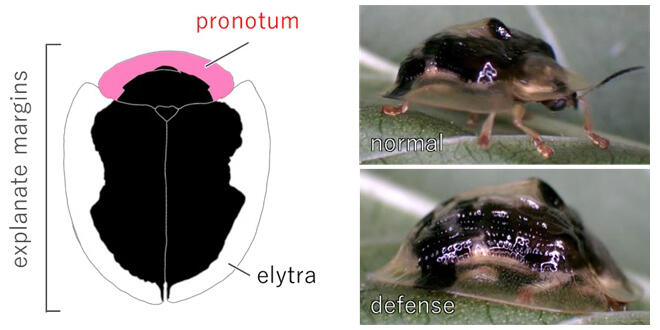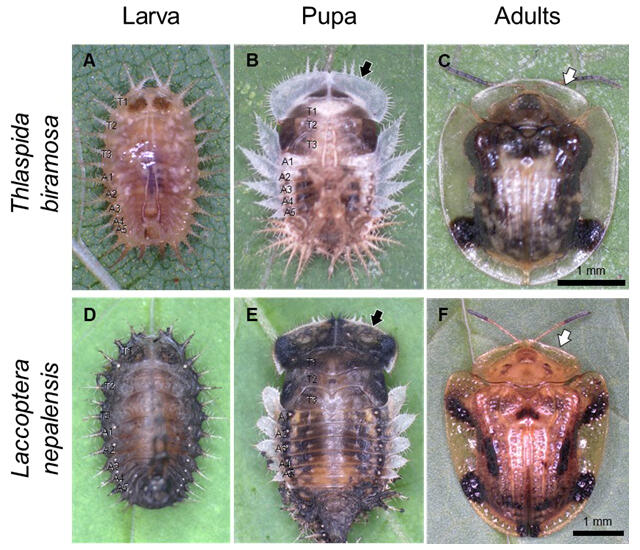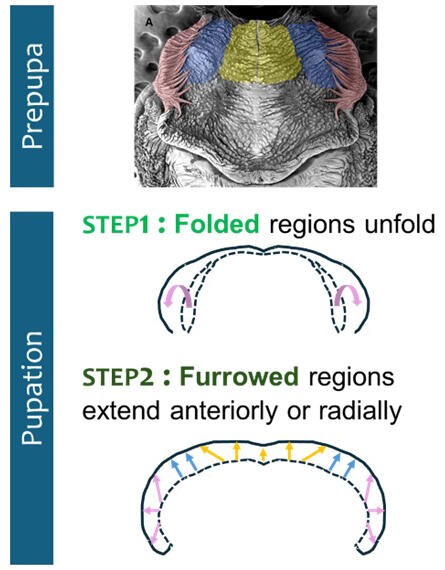A research group comprising Miho Ochiai, a student at the College of Agriculture (at the time of the study), Yuta Kurihara, a master's program student of the Graduate School of Agriculture (at the time of the study), and Professor Satoshi Miyazaki of Tamagawa University has reported, for the first time in the world, the detailed development process of the tortoise-shaped defense morphology, which is a common characteristic of tortoise beetles, clarified through a study in two insects of the family Chrysomelidae, Thlaspida biramosa and Laccoptera nepalensis. This mode of development may be common to tortoise beetles. The research results were published in Zoological Science.

Provided by Tamagawa University
Among the leaf beetles that feed on the leaves of specific plant species, there are about 3,000 species that exhibit unusual morphologies described as tortoise-shaped, helmet-shaped, disk-shaped, or bowl-shaped. These are collectively referred to as tortoise beetles. Strictly speaking, tortoise beetles refer to a monophyletic group within the large subfamily Cassidinae, which has about 6,400 species. Their tortoise-shaped structure is formed by the flattening and elongating of the pronotum, and the outer margin of the forewings is called the "pronotal explanate margin," which plays a defense role against predators. When they sense danger, they physically prevent themselves from becoming prey by keeping their head, legs, and antennae under the pronotal explanate margin and placing this margin in contact with the ground without gaps.
The research group conducted a detailed study on the developmental process of the pronotal explanate margin in two species, T. biramosa and L. nepalensis, both of which are found commonly in Tokyo. In both species, larvae molted four times before pupating, meaning that there were five larval instars. In none of those larval instars was a pronotal structure covering the head like the pronotal explanate margin in the adults. In contrast, a plate-like structure elongated to cover the head was observed in the pronotum of the pupae of both species. Based on these results, they hypothesized that the pronotal explanate margin is formed inside this plate-like structure.

Provided by Tamagawa University
To test this hypothesis, they observed the hatching process and confirmed that the pronotal explanate margin indeed arose from this plate-like structure. Thus, they were able to identify this plate-like structure as the primordium of the pronotal explanate margin. In the larval stage, there is no structure corresponding to the pronotal explanate margin.
Therefore, the group observed the pupation process to investigate the development of the primordium of the pronotal explanate margin. The results confirmed that the lateral margins of the pupal pronotum are folded so that they curl dorsally when the larvae shed their pronotal cuticle and that the folded structure is extended, and the lateral margins radially are unfolded from the anterior margin of the pronotum within a few minutes to form the pupal primordium. Furthermore, in T. biramosa, they experimentally removed the larval cuticle of the prepupae just before pupation and found that the pupal pronotal epithelium was finely folded in a region-specific manner. Structures with parallel transverse wrinkles are considered to extend only anteriorly, while structures with wrinkles in random directions are considered to extend anteriorly and laterally.
These results revealed a mechanism involving the formation of the finely folded pupal pronotal epithelium under the cuticle of the prepupae, followed by expansion of the primordium of the pronotal explanate margin upon pupation within which the pronotal explanate margin develops. A review of previous studies on the tortoise beetles identified at least 7 tribes, 15 genera, and 28 species, of which pupae had a primordium of the pronotal explanate margin, as in the case of the two species in the present study. Therefore, this developmental mechanism was considered to be common to many tortoise beetles.
The developmental pattern of the pronotal explanate margin in tortoise beetles revealed in this study is similar to that of novel traits such as insect wings, beetle horns, and treehopper helmets in that the "folded structure expands." In other words, the findings suggest that some commonality in developmental mechanisms underlies the diversification of insect morphology. Future studies on the molecular mechanisms of explanate margin development, not only in the prothorax part but also in the forewing part, are expected to help us understand the evolutionary process of novel trait development in the tortoise beetle phyletic line and the commonality and diversity in the novel trait development in insects.

Provided by Tamagawa University
Journal Information
Publication: Zoological Science
Title: Development of the Pronotal Explanate Margin, a Novel Evolutionary Trait in Tortoise Beetles
DOI: 10.2108/zs240026
This article has been translated by JST with permission from The Science News Ltd. (https://sci-news.co.jp/). Unauthorized reproduction of the article and photographs is prohibited.




